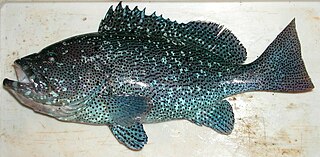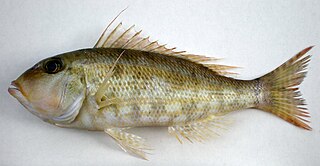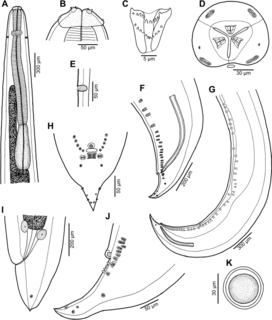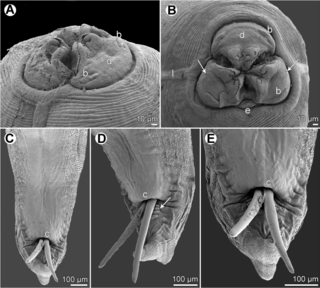
The grey reef shark is a species of requiem shark, in the family Carcharhinidae. One of the most common reef sharks in the Indo-Pacific, it is found as far east as Easter Island and as far west as South Africa. This species is most often seen in shallow water near the drop-offs of coral reefs. It has the typical "reef shark" shape, with a broad, round snout and large eyes. It can be distinguished from similar species by the plain or white-tipped first dorsal fin, the dark tips on the other fins, the broad, black rear margin on the tail fin, and the lack of a ridge between the dorsal fins. Most individuals are less than 1.88 m (6.2 ft) long.

The Anisakidae are a family of intestinal nematodes (roundworms). The larvae of these worms can cause anisakiasis when ingested by humans, in raw or insufficiently cooked fish.

Like humans and other animals, fish suffer from diseases and parasites. Fish defences against disease are specific and non-specific. Non-specific defences include skin and scales, as well as the mucus layer secreted by the epidermis that traps microorganisms and inhibits their growth. If pathogens breach these defences, fish can develop inflammatory responses that increase the flow of blood to infected areas and deliver white blood cells that attempt to destroy the pathogens.

Huffmanela branchialis is a parasitic nematode It has been observed on the gills of the fork-tailed threadfin bream Nemipterus furcosus, a nemipterid marine fish off New Caledonia. Its eggs are released from the gill mucosa with the turnover of living tissues and immediately continue their life-cycle.

Huffmanela filamentosa is a parasitic nematode It has been observed on the gills of the lethrinid fish Gymnocranius oblongus and Gymnocranius grandoculis off New Caledonia. Its eggs are released from the gill mucosa with the turnover of living tissues and immediately continue their life-cycle.

Huffmanela ossicola is a parasitic nematode. It has been observed in the branchial arch bone and the spinal cord bone of the labrid marine fishes Bodianus loxozonus, Bodianus busellatus and Bodianus perditio caught off New Caledonia. This is the first species of Huffmanela reported from bone tissue. Its eggs are only available for the continuation of the life-cycle after the host's death.

Capillariidae is a family of parasitic nematodes. All its members are parasites in vertebrates when they are in their adult stage.

Huffmanela is a genus of parasitic nematodes, belonging to the family Trichosomoididae.

The Trichosomoididae is a family of nematodes.

Huffmanela hamo is a parasitic nematode. It has been observed in the muscles of the dagger-tooth pike conger Muraenesox cinereus, a muraenesocid marine fish off Japan. Its life-cycle is unknown.
Philometra priacanthi is a species of parasitic nematode of fishes. Its name is derived from its host species, Priacanthus hamrur. It possesses dorsal lamella-like structures on the distal part of its gubernaculum, which can also be found on other of its cogenerates. The only species with a dorsal protuberance near the gubernaculum's end is P. priacanthi, however. P. lateolabracis can be distinguished from the former by the lateral caudal mounds separated dorsally, narrower lamella-like structures on its gubernaculum, shorter spicules, and by the testis extending anteriorly. Other gonad-infecting species differ from this one by possessing a smooth gubernaculum, and their spicules being of different lengths. Seven gonad-infecting species of Philometra can be distinguished from P. priacanthi by their host types, as well as by geographical distribution.

Philometra cyanopodi is a species of parasitic nematode of fishes, first found off New Caledonia in the South Pacific, in the gonads of Epinephelus cyanopodus. This species is characterized mainly by: length of spicules and length and structure of its gubernaculum; structure of male caudal end; body size; location in host and types of hosts.

Philometra lethrini is a species of parasitic nematode of fishes, first found off New Caledonia in the South Pacific, in the gonads of Lethrinus genivittatus. This species is characterized mainly by: length of spicules and length and structure of its gubernaculum; structure of male caudal end; body size; location in host and types of hosts.

Cucullanus is a genus of parasitic nematodes. The genus includes more than 100 species.

František Moravec is a Czech parasitologist who specialised on the Nematodes, especially the nematodes parasites of fishes. His research was mainly in the field of taxonomy of the Nematoda.

Ascarophis is a genus of parasitic nematodes, belonging to the family Cystidicolidae. Species of Ascarophis are parasitic as adults in the gastrointestinal tract of marine and estuarine fishes.

Ascarophisnema is a genus of parasitic nematodes, belonging to the family Cystidicolidae. Species of Ascarophisnema are parasitic as adults in the gastrointestinal tract of fish. According to the World Register of Marine Species, the genus currently (2019) includes a single species, Ascarophisnema tridentatum.
Metabronemoides is a genus of parasitic nematodes, belonging to the family Cystidicolidae. Species of Metabronemoides are parasitic as adults in the gastrointestinal tract of fish.

Euterranova is a genus of parasitic nematodes that have life cycles involving elasmobranchs. The genus was created in 2020 to accommodate species which were previously included inTerranovaLeiper & Atkinson, 1914 a taxon considered to be invalid.

Neoterranova is a genus of parasitic nematodes that have life cycles involving sharks and reptiles. The genus was created in 2020 to accommodate species which were previously included inTerranovaLeiper & Atkinson, 1914 a taxon considered to be invalid.



















